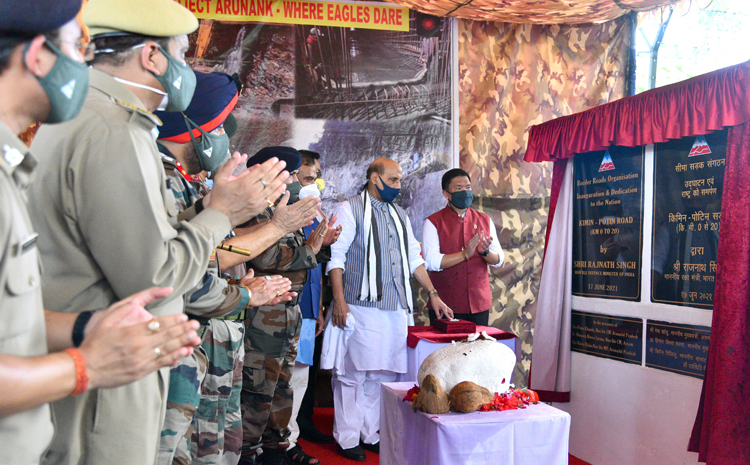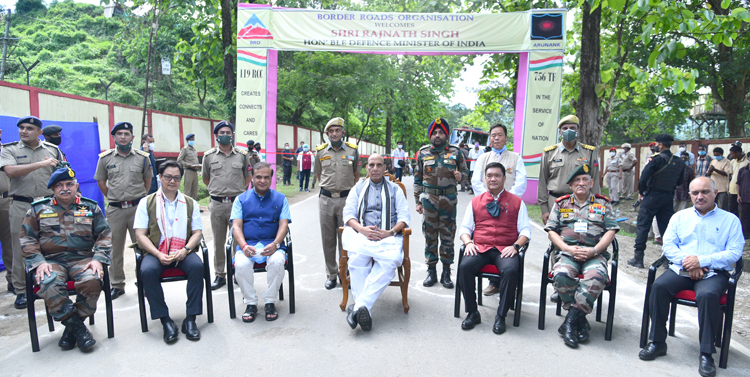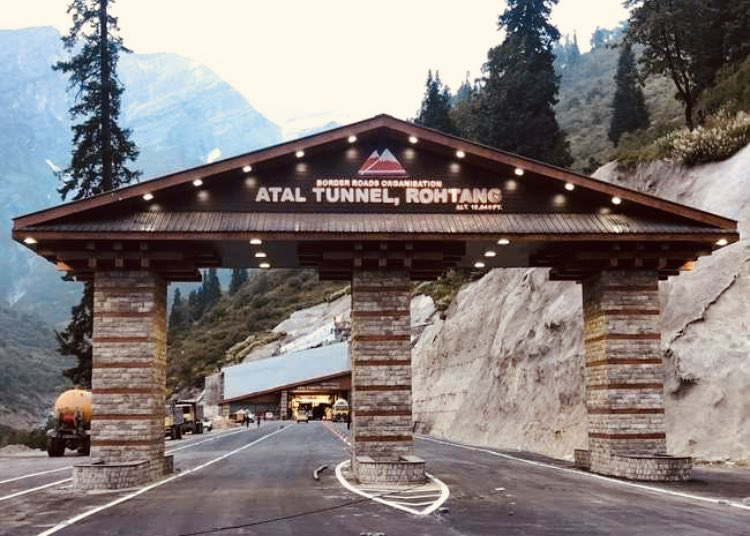INDIAN ARMED FORCES CHIEFS ON OUR RELENTLESS AND FOCUSED PUBLISHING EFFORTS

The insightful articles, inspiring narrations and analytical perspectives presented by the Editorial Team, establish an alluring connect with the reader. My compliments and best wishes to SP Guide Publications.

"Over the past 60 years, the growth of SP Guide Publications has mirrored the rising stature of Indian Navy. Its well-researched and informative magazines on Defence and Aerospace sector have served to shape an educated opinion of our military personnel, policy makers and the public alike. I wish SP's Publication team continued success, fair winds and following seas in all future endeavour!"

Since, its inception in 1964, SP Guide Publications has consistently demonstrated commitment to high-quality journalism in the aerospace and defence sectors, earning a well-deserved reputation as Asia's largest media house in this domain. I wish SP Guide Publications continued success in its pursuit of excellence.
- Operation Sindoor: Resolute yet Restrained
- India’s Operation Sindoor Sends a Clear Message to Terror and the World – ‘ZERO TOLERANCE’
- Japan and India set forth a defence cooperation consultancy framework, talks on tank and jet engines
- Terrorist Attack in Pahalgam in Kashmir: Unfolding a long surgical war against PAK
- Lt General Pratik Sharma takes over Command of Indian Army's Northern Command
Border Infrastructure
The Chinese aggression in 2020 has woken up India to its strategic inadequacies including in border infrastructure
 |
The Author is Former Director General of Information Systems and A Special Forces Veteran, Indian Army |

On June 17, 2021, Defence Minister Rajnath Singh dedicated 12 strategic roads to the nation. Of these, 10 are in Arunachal Pradesh and one each in Ladakh and J&K. Inaugurating the 12 roads built by the Border Roads Organisation (BRO) electronically at a ceremony in Lakhimpur District of Assam, Rajnath Singh said, "The ability of Border Roads Organisation to build world class roads despite challenges in hilly and difficult terrain reflects the mantra of 'Atmanirbhar Bharat'. Strategic roads will not only boost connectivity, but will also enable faster movement of security forces along international borders. India seeks peace but knows how to respond befittingly if anyone shows us an aggressive attitude." He further said that the construction of these strategic roads is part of the Act East Policy of the Central Government.
The Chinese aggression in 2020 has woken up India to its strategic inadequacies including in border infrastructure. In 1999, construction of 73 strategically important roads totaling 4,643 km length was approved along the border with China. Of the 61 roads totaling 3,323 km assigned to the BRO, 45 have been completed. However, connectivity has been achieved in 59 roads under BRO while seven of the last nine roads will be completed by March 22 and the remaining two by March 2023. According to BRO, 74 permanent bridges and 33 Bailey bridges over the last one year and that "some" forward locations like Yangtse in Arunachal Pradesh have also been connected. Overall, BRO has completed 1,200 km of 'road formation works' and 2,850 km of 'surfacing works' in last one year. Of this 1,200 km, 162 km is in Rajasthan and balance 1,038 km along the northern border from J&K to Arunachal Pradesh.
Another important issue is the construction and maintenance of border roads especially when large portions are handed over to the state governments

Above is good progress no doubt but the question we should be asking ourselves is whether it is 'enough' compared to the far superior border infrastructure of China which is being further expanded at a very fast pace, not about just the new road constructed 5-km short of Galwan and another road connecting Finger 4 on the North Bank of Pangog Tso. Witness China's feverish pitch of completing the Lhasa-Nyingchi high-speed railway network by end June 2021 terminating less than 15 km opposite Tuting Sector in Arunachal Pradesh.
Compare the above to discovering in December 2017 China constructing new road in three feet of snow that had already intruded 1.5 km across the LAC in Tuting area. Our Bishing village about a day's walk from the intrusion area did not even have a motorable road because of the norm of not providing roads for villages with less than 100 population under the Pradhan Mantri Gram Sadak Yojna (PMGSY).
Not planning and constructing the Shinku La tunnel simultaneous to the Atal Tunnel indicates lack of inclusive thinking and strategic sense
The 73 strategic roads were approved in 1999 but the requirement needs constant review as indicated by the Chinese road construction in Tuting area during December 2017 and now the Lhasa-Nyingchi railway network being completed opposite Tuting in June 2021. This is only one example why we need a periodic review of road construction in border areas. In addition are the roads we would need for our own offensive plans, which may be projected for connecting border villages.
Another important issue is the construction and maintenance of border roads especially when large portions are handed over to the state governments. When the Bogibeel Bridge over Brahmputra River was inaugurated by Prime Minister Narendra Modi on December 25, 2018, road north of it through Assam (constructed by BRO and handed over to the State Government about two years ago) was in terrible state. Initial few km through paddy fields without revetments on both sides had caused the road to cave in every 50 metres.
In March 2017, the Comptroller and Auditor General (CAG) in its report, adversely commenting on roads built by BRO, pointed out numerous instances of defective construction due to unsuitable design or specifications, steep gradient, defective alignment, turning problems for vehicles, improper contract management, poor riding conditions, inadequate drainage and non-connectivity aside from delays, additional expenditure of Rs 63.20 crore on account of corrective action, in addition to non-completion and faulty specifications of works having serious bearing on operational capability of the Armed Forces. Also, surfacing of new roads gets skewed with just one winter and in many forward areas the inadequate width forces one way convoy system. Hence, only length of roads is not important but execution and maintenance is the crux.

The Atal Tunnel at Rohtang inaugurated by Prime Minister Narendra Modi last year enables a journey from Manali Valley to Lahaul and Spiti Valley in little over ten minutes compared to the around five hours it took earlier. It provides all weather connectivity to population of Lahaul and Spiti Valley that remained cut off in winters for nearly six months. But all weather connectivity to troops deployed in Ladakh will take much more time. Now focus is on constructing the 9.2 km long Shinku La tunnel at altitude over 9,800 feet connecting Himachal Pradesh with J&K; making the 475 km long Manali-Keylong-Leh highway an all weather road to serve troops in Ladakh facing China and Pakistan throughout year. But not planning and constructing the Shinku La tunnel simultaneous to the Atal Tunnel indicates lack of inclusive thinking and strategic sense.
The 14 strategic railway lines planned to serve the borders with China and Pakistan remain largely on paper and will take years to build
Making the Manali-Leh direct route all weather beyond the Atal Tunnel would require another three tunnels: 13.2 km long tunnel to negotiate the 16,040 feet high Baralacha Pass; 14.78 km long tunnel at Lachung La pass at 16,800 feet, and, 7.32 km long tunnel at Tanglang La Pass at 17,480 feet. We should work on these as an alternative in case the Chinese interdict the Manali-Keylong-Leh during conflict.
The 14 strategic railway lines planned to serve the borders with China and Pakistan remain largely on paper and will take years to build. The current standoff with China and PLA build up and actions indicate that an India-China conflict is very much on the cards. Even scholars who believe in following the 'middle path' in order to cover up the hierarchical neglect of national security say that an India-China conflict within a decade is a certainty. But why would China wait for us to build our border infrastructure and improve our defence capability. India is not a poor nation anymore with Forex reserves at $605 billion, we need to hasten up our border infrastructure and build up our defence capabilities post haste.





